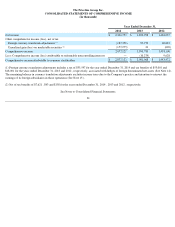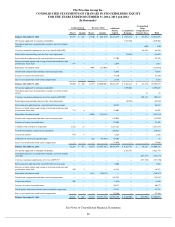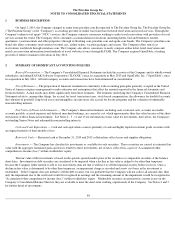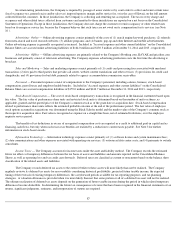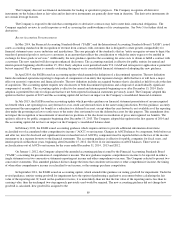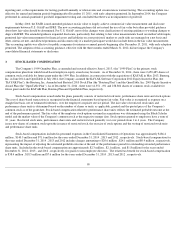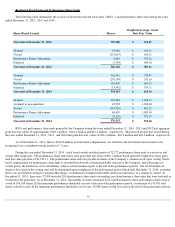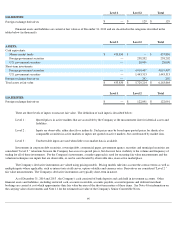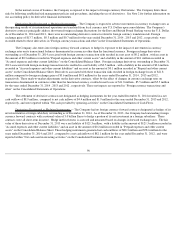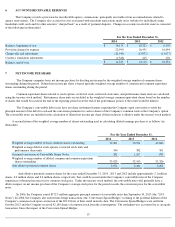Priceline 2014 Annual Report Download - page 93
Download and view the complete annual report
Please find page 93 of the 2014 Priceline annual report below. You can navigate through the pages in the report by either clicking on the pages listed below, or by using the keyword search tool below to find specific information within the annual report.
Deferred taxes are measured using the enacted tax rates expected to apply to taxable income in the years in which those temporary
differences are expected to be recovered or settled. The effect on deferred taxes of a change in tax rates is recognized in income in the period
that includes the enactment date of such change.
Income taxes are not accrued for unremitted earnings of international operations that have been or are intended to be reinvested
indefinitely.
The Company recognizes liabilities when it believes that uncertain positions may not be fully sustained upon review by the tax
authorities. Liabilities recognized for uncertain tax positions are based on a two step approach for recognition and measurement. First, the
Company evaluates the tax position for recognition by determining if the weight of available evidence indicates it is more likely than not that the
position will be sustained on audit based on its technical merits. Secondly, the Company measures the tax benefit as the largest amount which is
more than 50% likely of being realized upon ultimate settlement. Interest and penalties attributable to uncertain tax positions, if any, are
recognized as a component of income tax expense. See Note 15 for further details on income taxes.
Segment Reporting — The Company determined that its brands constitute its operating segments. Based on similar economics
characteristics and other similar operating factors, the Company has aggregated the operating segments into one reportable segment. The
Company manages its business as one unit. For geographic related information, see Note 18 .
Foreign Currency Translation — The functional currency of the Company's foreign subsidiaries is generally their respective local
currency. Assets and liabilities are translated into U.S. Dollars at the rate of exchange existing at the balance sheet date. Income statement
amounts are translated at average monthly exchange rates applicable for the period. Translation gains and losses are included as a component of
"Accumulated other comprehensive income (loss)" on the Company's Consolidated Balance Sheets. Foreign currency transaction gains and
losses are included in "Foreign currency transactions and other" in the Company's Consolidated Statements of Operations.
In September 2014, the Company issued Senior Notes due September 23, 2024 for an aggregate principal amount of 1.0 billion Euros
and designated the carrying value, plus accrued interest, as a hedge of the Company's net investment in a Euro functional currency subsidiary.
The foreign currency transaction gains or losses on these liabilities and the Euro denominated net assets of the subsidiary are translated into U.S.
Dollars and are included as a component of "Accumulated other comprehensive income (loss)" on the Company's Consolidated Balance Sheet
(see Notes 11 and 14).
Derivative Financial Instruments — As a result of the Company's international operations, it is exposed to various market risks that
may affect its consolidated results of operations, cash flow and financial position. These market risks include, but are not limited to, fluctuations
in currency exchange rates. The Company's primary foreign currency exposures are in Euros and British Pound Sterling, in which it conducts a
significant portion of its business activities. As a result, the Company faces exposure to adverse movements in currency exchange rates as the
financial results of its international operations are translated from local currency into U.S. Dollars upon consolidation. Additionally, foreign
exchange rate fluctuations on transactions denominated in currencies other than the functional currency result in gains and losses that are
reflected in income.
The Company may enter into derivative instruments to hedge certain net exposures of nonfunctional currency denominated assets and
liabilities and the volatility associated with translating earnings for its international businesses into U.S. Dollars, even though it does not elect to
apply hedge accounting or hedge accounting does not apply. Gains and losses resulting from a change in fair value for these derivatives are
reflected in income in the period in which the change occurs and are recognized on the Consolidated Statements of Operations in "Foreign
currency transactions and other." Cash flows related to these contracts are classified within "Net cash provided by operating activities" on the
cash flow statement.
The Company, from time to time, utilizes derivative instruments to hedge the impact of changes in currency exchange rates on the net
assets of its foreign subsidiaries. These instruments are designated as net investment hedges. Hedge ineffectiveness is assessed and measured
based on changes in forward exchange rates. The Company records gains and losses on these derivative instruments as currency translation
adjustments, which offset a portion of the translation adjustments related to the foreign subsidiary's net assets. Gains and losses are recognized
on the Consolidated Balance Sheet in "Accumulated other comprehensive income (loss)" and will be realized upon a partial sale or liquidation of
the investment. The Company formally documents all derivatives designated as hedging instruments for accounting purposes, both at hedge
inception and on an on-going basis. These net investment hedges expose the Company to liquidity risk as the derivatives have an immediate
cash flow impact upon maturity, which is not offset by the translation of the underlying hedged equity. The cash flows from these contracts are
classified within "Net cash used in investing activities" on the cash flow statement.
88




